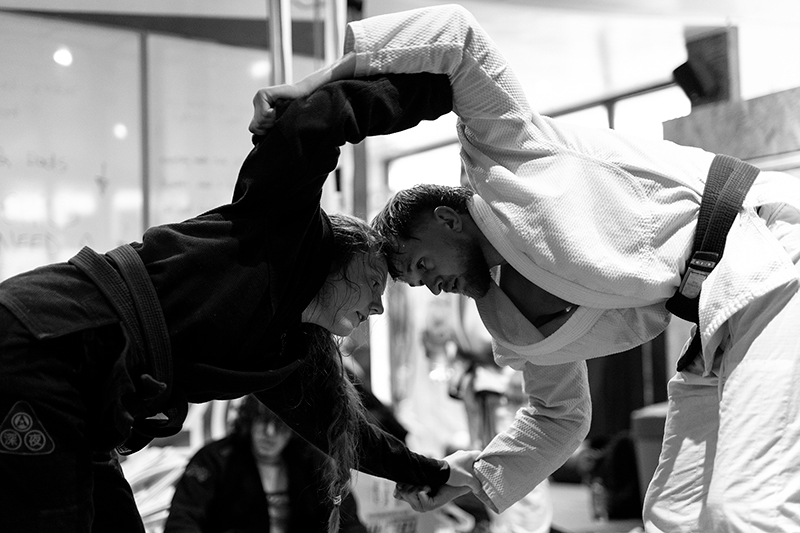
HISTORY OF BRAZILIAN JIUJITSU
Brazilian Jiu-Jitsu is a martial arts based in ground fighting. It was formed from Judo ground fighting fundamentals that were taught to Carlos Gracie by master Mitsuyo Maeda as a appreciation for his help. Carlos then taught all the other children in his family including the smallest and youngest of his brothers, Helio. Helio often felt at a disadvantage when practicing with his brothers because many of the moves in judo favored the stronger and bigger fighters. As a result of this, Helio developed an offshoot of Maeda’s teachings that favoured leverage over strength and refined the formula for fighting from one’s back on the ground.
Jiu-Jitsu burst on to the scene in the martial arts community in the early 1990s, when Brazilian jiu-jitsu expert Royce Gracie won the first UFC. Royce fought against often much larger opponents who were practising other styles, including boxing, shoot-fighting, Muay Thai, karate, wrestling, judo and tae kwon do.
BJJ training can be used for grappling tournaments and mixed martial arts (MMA) competition or self-defence. It teaches takedowns, takedown defense, ground control, and especially submissions.
BJJ CLASS INFORMATION
Brazilian Jiu-Jitsu at Ippon gym is being taught by BJJ black belt holder Jeff Lawson. The classes cater for all levels from beginner to advanced. Our members regularly compete in BJJ tournaments locally and internationally as we find this is the best way for our students to see their progression within the sport.


BJJ RULES AND SCORING
Each BJJ contest has slightly different scoring system but on the whole the scoring is as follow.
The valid moves are those which seek to neutralise, immobilise, strangle and apply any kind of pressure by the twisting joints, as well as knocking down one’s opponent by take-down.
The non-valid moves which are considered illegal: biting, hair pulling, sticking fingers in the eyes or nose of one’s opponent, striking the opponent’s genitalia, finger twisting, and any other move that gains unfair advantage with use of one’s fists, feet, elbows or head.
Advantages: When there is a draw in the number of points, the athlete with the most advantage points shall be declared the winner.
Penalties: When there is a draw in the number of points and advantage points, the athlete with the least penalty points counted against him/her shall be declared the winner.
BENEFITS OF BRAZILIAN JIU JITSU
- Health & wellbeing
- Weight loss
- Increased flexibility
- Self defense
- Increased confidence
- Conditioning
- Social interaction
- Healthy competition


EQUIPMENT
We train with gi which is a two piece judo-like suit and belt. You can buy gi from Tatami Fightwear and Scramble.
If you are new to Brazilian Jiu Jitsu and don’t have a gi then you can train in thin, flexible tracksuit bottoms or shorts and a t-shirt.
Please be aware that there should be no zips, buttons or pockets on any item of clothing.
FAQs
Call us or email us and we can book you into the class that suits your level of experience.
After the class an instructor will go through our simple membership options.
Yes, you need to book a class through Team up system. We will give you the link to the app once you’ve signed up for a membership.
Give us a call on 07824875546 or email info@ippongym.com and we can arrange this through one of our self-employed trainers.
Normal gym gear but with no zips and no buttons.
Not for your first class. At the later stage you may want to wear a mouthguard.
This is the traditional training suit used in our grappling classes. You can buy them at www.tatamifightwear.com or www.scramblestuff.com.
Gi and No Gi are the two forms of Brazilian Jiu-Jitsu. Gi Jiu Jitsu is grappling with the use of a traditional Gi, which allows you to grab the clothing of your opponent. No Gi is grappling without the traditional uniform, instead you wear shorts and a rash guard. In no Gi class you cannot grab your opponent’s clothing.
The Brazilian Jiu Jitsu ranking system is a way of representing a student’s increasing level of technical knowledge and practical skills in BJJ. Belts and stripes can be awarded to students by a Black Belt practitioner. Belts indicate student’s rank in Brazilian Jiu-Jitsu.
There are 5 belts in for adults and 13 belts for children until they reach the age of 16.
White belt
This is the first belt in Brazilian Jiu Jitsu and the beginning rank for all BJJ students who have never practised BJJ before.
Blue belt
The 2nd adult rank in Brazilian Jiu Jitsu. At this level, students gain technical knowledge and put hours into practise learning an efficient implementation of these moves. At this level you should have a strong understanding of fundamental movements, a broad range of basic techniques, good defence, and escape skills.
Purple belt
Purple belt is given to students with a large amount of knowledge. This is an advanced rank in this sport. Purple belts are usually considered qualified to help instruct lower ranked students. According to the IBJJF, a purple belt must remain their rank for 18 months before becoming eligible for brown belt.
Brown belt
Brown belt is usually achieved after at least 5 years of dedicated BJJ training. A brown belt fully understands Jiu jitsu and is making small adjustments to his or her game while moving towards a black belt. The BJJ brown belt knows how to be dominate the opponent from any position and how to be two to three steps ahead of their opponent. The IBJJF requires one year of brown belt before becoming eligible for black.
Black belt
this is the highest belt within Brazilian Jiu Jitsu given to a practitioner with an expert level of technical and practical skills.
Stripes (degrees)
Whilst a student at Ippon Gym you will also receive numerous stripes between belts. Stripes indicate levels in BJJ with four levels to each stripe. They demonstrate your progress towards the next rank. You receive these stripes from white to brown belt.
Further stripes in black belt can be achieved through merit, dedication and a lifelong commitment to this martial arts.
Unlike some other martial arts, promotion in BJJ is a very strict and difficult to progress through. The progress is also never linear. You may spend years at one belt and only one year at another. BJJ is considered one of the most challenging martial arts; hence belt promotions are highly respected and thought through.
Being promoted will be one of the most rewarding moments of your BJJ journey. It means that you manage to overcome many physical and mental challenges and that you’ve proven yourself skill wise.
Even if you instruction isn’t testing you, he is probably watching your every move, especially if he deems you worthy of a promotion. You may be asked to spar with someone of a higher rank or bigger opponent. Based on this spar, the instructor will gauge whether you have demonstrated a high level of accuracy and efficiency according to your belt level or higher.
The factors that will influence your promotion include the technical knowledge, skills, sparring performance, your character and dedication and the consistency of training.
We have them to lend you.
Classes start with sports specific warm up followed by techniques and the specific sparring.
The ones marked clearly on our timetable.
Things are starting to become easier for you to do in the classes.
Not fit at all.
Never too old.
